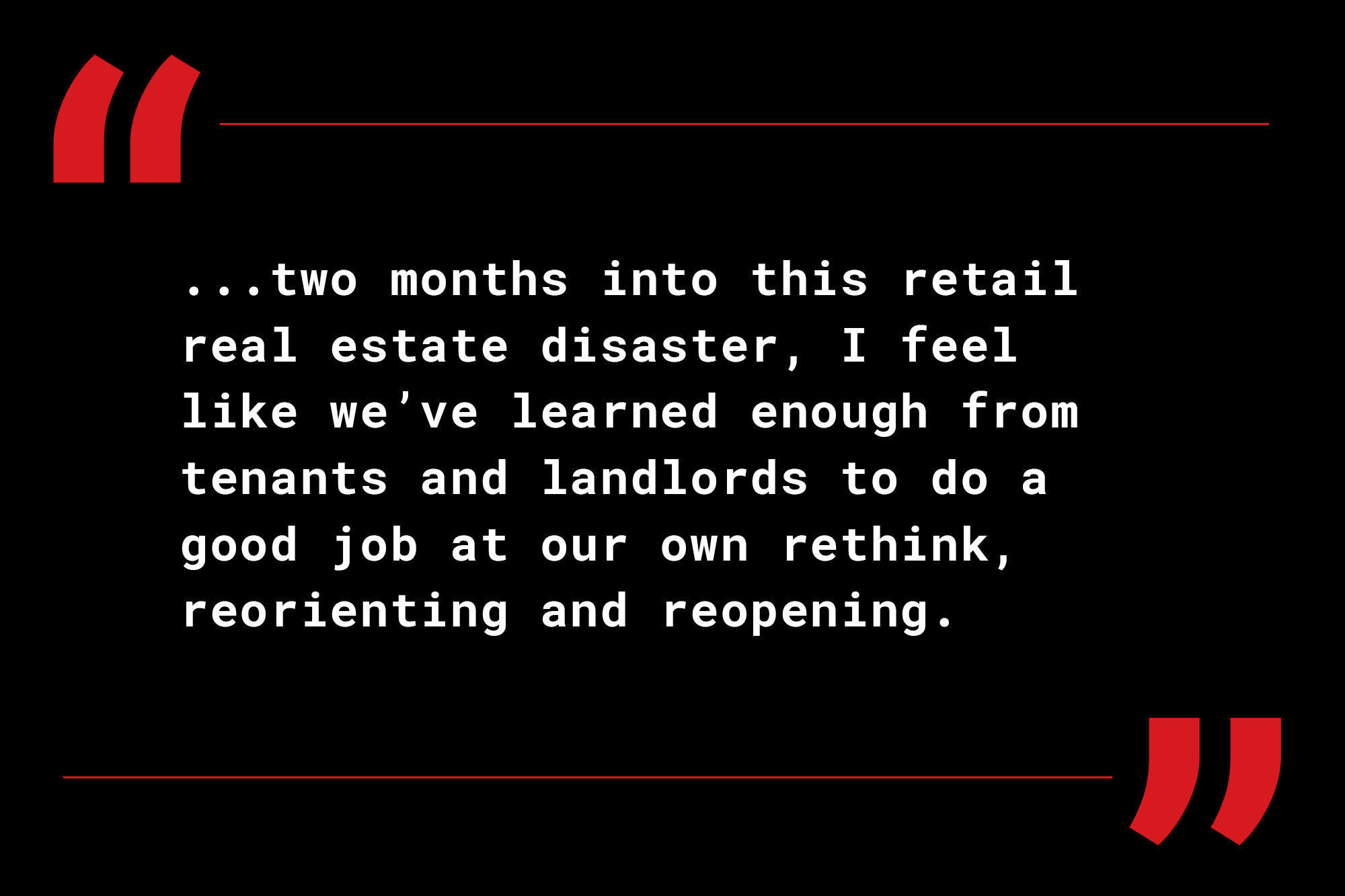Update #9: Rebuild. Rethink. Reopen…
Dear Clients & Colleagues,
All things “re-” are dominating our lives, news feeds, and thinking – Recalibrate. Rewrite. Replace. Redevelop. Redesign. Retenant… and of course, Reopen. But none of us really have much of a clue about how all this rebuilding, rethinking and reopening will play out in the real world. One thing I am sure of though is that in retail it is going to be really messy; and really complicated; and it is all going to move really, really fast. Through it all we at Graffito are trying to achieve the discipline needed to keep learning, communicating, and sharing… and then revisiting all of what we thought we knew last month.
This revisiting of what we once knew and perviously learned has been one of the most powerful things about writing these weekly updates and talking with you all over the past few weeks. And it’s been one of the most amazing parts of working at Graffito these past few months too. We are learning a ton. And relearning a lot of what we thought we knew.
So today, for this update #9, I’m revisiting two of the core sections I hit in update #3: Tenant Realities and Landlord Considerations.
I. Tenant Realities
Most of our thinking in March and April was focused here — on the tenant realities, because it’s impossible to fully process the landlord realities without first thinking through the actual issues facing the actual land users. Our understanding of the complexity here has evolved a lot since update #3, but sadly the same questions persist (supply chain questions, reopening complexities, customers behavior, etc).
Today, unlike in March, it is safe to say with certainty that COVID-19 has touched all businesses selling anything to the public, whether online in or in-person. Every single retailer in the past two months we have spoke to — and we are talking to a lot of retailers — is thinking about changing their business model in some way. The scale of the collective rethink in retail is just nuts.
Here’s some stuff you may not have thought about yet:
1. Grocery stores are thriving (from a revenue perspective) but the good ones are dealing with wildly complex staffing, communications, design, and supply chain issues. If you want to scratch the surface of these issues take a quick peak at this (very impressive) publication Kroger just pushed out: Sharing What We’ve Learned: A Blueprint for Businesses.
While it may seem like smooth sailing for grocery stores, we aren’t convinced yet, especially those that don’t have strong delivery and local vendor relationships. The Kroger doc previews this. And most importantly, it previews the multitude of challenges that all retailers are facing as they try to reopen and reposition.
2. Digitally Native Brands (i.e. Away, Warby Parker, Outdoor Voices, Casper, etc.) that some think are still well positioned for future brick-and-mortar growth are in fact getting dragged down by their own aggressive retail strategies of the past few years (and related labor costs associated with such stores). Many of these new-age (and millennial focused) e-commerce companies have signed very expensive leases in high-rent districts and, as of today, are actively renegotiating leases and considering giving space back.
It’s my suspicion that a slew, but not all, of these digitally native brands will retreat from their previously planned store expansion plans. This will touch so many urban real estate projects in place like the Seaport, Back Bay and even Harvard Square. These users partial retraction will change the face of what, pre-coronavirus, we thought the future of retail was going to look like.
3. Taprooms & Breweries that have been a massive bight-spot in the urban retail landscape of the past few years in places like Boston, Philly, Brooklyn, Chicago and Portland (OR + ME) are going through immense changes too. Process this: there is currently no business for kegs. Taps aren’t being used. The entire industry is shifting to cans in the near-term and brewers without A+ canning facilities and strong local distribution are going to really struggle for the next few years. This changes many leasing plans indefinitely, as taprooms and breweries had become one of the standard defaults for what to do with big urban retail spaces that weren’t going to work for a restaurants or other large(r) format user.
The above three example just scratch the surface of some of what we are seeing. Again, it is wholesale change. And again, it’s nuts.
II. More Landlord Considerations
Making sense of what you all are facing can be even more complex than what retailers are facing. It’s more layered. Landlords have the challenge of trying to understand the dozens and dozens of retail businesses in their buildings and projects. It’s a somewhat impossible task at times, especially for mixed-use developers, and it is why so many of you hire us. Of the small handful of our clients that are retail focused, they look to us for more narrow services — i.e. to focus exclusively on deals with locals, to help with storytelling and permitting efforts, or to suppliment existing teams spread out across the region or country. Despite a sometimes limited scope, it is this work for experienced retail landlords that has been some of the most valuable and rewarding work for us over the last ten years. Past and present engagements with the likes of Jamestown, Tishman Speyer, Samuels, Northpond, Forest City, and Federal Realty have allowed us to learn from the true pros in the industry, and today, as landlords shift to reopening and redesigning their projects, we’ll be watching closely what retail-focused owners are doing.
Case in point, as related to reopening, there are a few current efforts by very seasoned retail landlords that drew my attention last week. Two really strong, one not so much. The latter effort is from Simon Properties Group, who in their “Reopening Update” of May 4th to all of their tenants presented an oddly rosy picture of the world, suggesting that sales numbers were better than expected in malls that opened the first week of May, and that there was an overabundance of pent-up consumer demand. As part of the reopening email they sent to their tenants they shared this “Welcome Back” video, which candidly makes me feel like never going to a mall again. But maybe that’s just me. And maybe there is pent-up demand that fuels a COVID-19 retail resurgence before a vaccine…
What’s missing in Simon’s reopening message is that it lacks any sort of acknowledgement of the severity of this crisis. It suggests to tenants that, other than new health and safety protocols, no rethink is needed. This is wrong. A better approach, for example, is Jamestown’s messaging on reopening, which was posted to their Small Business Portal: “Not business as usual, that much we can all agree on. Reopening F&B outlets in the near-term means much more than simply unlocking your doors. It should involve detailed planning and implementation of new processes to put your customers at ease. Putting all this together will take time prior to opening, and tighter controls and management after opening, so get started now.”
Another example of strong action by a retail landlord is what Federal Realty is doing with their new curbside pickup program (see: Federal Introduces The Pick-Up), which comes on the heels of announcing a local initiative with the City of Somerville and Partners Healthcare for a N95 mask decontamination facility at Assembly Row. Federal, like Jamestown, is demonstrating that they “get it” beyond providing hand sanitizer and monitoring occupancy counts. Landlords that are (re)thinking in this way and communicating in this way — like many of you — by going beyond standard guidelines will benefit. Not just because retailers in said projects will have more support to do better business in the next couple years, but because as I also noted in update #3 “when we finally get back to a moment in time when retailers and restaurateurs are looking for new deals (and we will get there), I sincerely believe tenants will make certain real estate decisions based on the way landowners handled this crisis…”
It is the flexible and opportunistic landowners that also grasp the gravity of the current crisis that will come out of this as winners. We desperately want all of you to be this sort of landlord. Now we just need to figure out how Graffito can best help…
III. The Graffito Rethink
Now, finally, what does all of this mean for Graffito?
Like our retailer friends — and many of you — we are going to have to go through our own reopening. And I’m not talking about reopening our office space in the Leather District. I’m talking about reinventing, rewriting, and redesigning certain core parts of our own business. And frankly, everything is on the table.
We are currently talking to a range of new and exciting partners that will help us get smarter and do more impactful and informed work. But talk is easy right now, so we hope to be announcing some new initiatives and projects in May and June. First up will be the launch of Graffito ID, our branding and creative services business, because now more than ever visual messaging and graphic design matters.
In sum, two months into this retail real estate disaster, I feel like we’ve learned enough from tenants and landlords to do a good job at our own rethink, reorienting and reopening. We’ll be spending a lot of time on this in the weeks ahead. And we’ll be keeping you posted via the blog.
Please keep in touch this week and I’ll be back to you soon with Update #10.
Onward,
/Jesse




